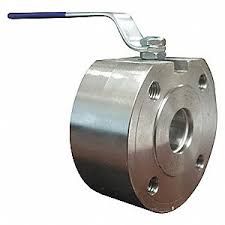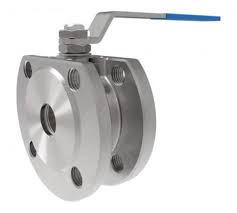Wafer Ball Valve

The Application of Wafer Ball Valve
The Cameron brand is renowned for its high-quality industrial valves, including the versatile wafer ball valve. The wafer ball valve design, characterized by its compact and lightweight construction, makes it an excellent choice for a wide range of applications. These valves are commonly fabricated from stainless steel, ensuring superior corrosion resistance and durability, making them well-suited for use in harsh environments. The wafer style ball valve offers a space-saving solution, allowing for easy installation between flanges in piping systems. With their reliable performance and comprehensive product range, Cameron’s wafer ball valves are widely employed in various industries, including petrochemical, oil and gas, water treatment, and general industrial processes, where precise flow control and dependable shutoff are paramount.
What Are The Types Of Wafer Ball Valve?
- Standard Wafer Ball Valve:
- The most common type of wafer ball valve.
- Designed to be installed between pipe flanges.
- Provides on/off flow control.
- Available in a wide range of materials, including stainless steel, carbon steel, and various alloys.
- Lug Wafer Ball Valve:
- Has threaded holes in the valve body for bolting directly to the flanges.
- Provides a secure connection without the need for separate flange bolts.
- Suitable for higher-pressure applications.
- High-Performance Wafer Ball Valve:
- Incorporates advanced design features for enhanced performance.
- May include features like full-bore flow, fire-safe construction, and low-torque operation.
- Often used in critical applications with demanding requirements.
- Reduced Port Wafer Ball Valve:
- Has a reduced port size compared to the pipe diameter.
- Provides throttling and flow control capabilities.
- Useful for applications where precise flow regulation is required.
- Cryogenic Wafer Ball Valve:
- Designed for use in low-temperature applications, such as liquefied gas systems.
- Utilizes specialized materials and seals to withstand cryogenic conditions.
- Three-Piece Wafer Ball Valve:
- Consists of a valve body with a removable center section.
- Allows for easier maintenance and servicing without disrupting the pipeline.
What Is Wafer Ball Valve?
A wafer ball valve is a type of industrial valve that features a compact, lightweight design suitable for installation between pipe flanges. The valve’s main component is a spherical ball with a bore that aligns with the pipe flow when the valve is open, allowing unobstructed fluid passage. To operate the valve, the ball rotates 90 degrees between the open and closed positions, either permitting or blocking the flow. The wafer style of the valve body allows it to be sandwiched between two pipe flanges, eliminating the need for additional body length and providing a space-saving solution. Wafer ball valves are commonly constructed from durable materials such as stainless steel, making them well-suited for use in various industrial applications where reliable flow control and shut-off are required.
How to Select the Right Wafer Ball Valve?
Materials of Construction: Choose a valve material, such as stainless steel, that is compatible with the process fluid and can withstand the required temperature and pressure conditions. This ensures the valve’s durability and corrosion resistance.
Pressure Rating: Determine the maximum operating pressure the valve needs to handle and select one with a suitable pressure rating, typically ranging from low-pressure to high-pressure applications.
Size and Port Configuration: Match the valve’s size and port design to the pipe dimensions and flow requirements, ensuring optimal performance and minimal pressure drops.
Certifications and Standards: Verify that the wafer ball valve meets relevant industry standards and certifications, such as ASME, API, or ISO, depending on the application.
By carefully evaluating these critical parameters, users can ensure the selection of a wafer ball valve that will provide reliable, safe, and efficient operation within their specific system requirements.
Features of Wafer Ball Valve
Compact Design:
Wafer ball valves feature a compact and lightweight body design, allowing for easy installation between pipe flanges and reducing the overall space required in the piping system.
Bidirectional Flow:
These valves are capable of controlling fluid flow in both directions, making them suitable for a wide range of applications where reversible flow may be required.
Reliable Shutoff:
The tight sealing between the ball and the valve seats ensures reliable shutoff performance, preventing leaks and maintaining system integrity.
Corrosion Resistance:
Wafer ball valves are often constructed from corrosion-resistant materials, such as stainless steel, to withstand exposure to harsh chemicals, fluids, and environmental conditions.
High-Temperature Capability:
Certain wafer ball valve designs are engineered to operate at elevated temperatures, expanding their applications in industries like petrochemicals and power generation.
Low Maintenance:
The simple, one-piece body design of wafer ball valves reduces the number of potential leak points and simplifies maintenance, contributing to their overall reliability and longevity.
Advantages and Disadvantages of Wafer Ball Valve
Advantages of Wafer Ball Valve:
Space-saving Design:The compact wafer configuration allows for easy installation between pipe flanges, reducing the overall footprint in the piping system.Bidirectional Flow Control:Wafer ball valves can handle flow in both directions, providing versatility and flexibility in various applications.Rapid Shut-off:The ball design enables quick and reliable shutoff, making these valves suitable for emergency situations or process control applications.Corrosion Resistance:The use of corrosion-resistant materials, such as stainless steel, enhances the valve’s durability and extends its service life in harsh environments.Low Maintenance:The simple design and minimal number of components contribute to the low maintenance requirements of wafer ball valves.Disadvantages of Wafer Ball Valve:Limited Throttling Capability:Wafer ball valves are primarily designed for on/off flow control and may not be the best choice for precise flow throttling applications.Potential for Leakage:Over time, the seals and gaskets in a wafer ball valve can wear down, increasing the risk of leakage if not properly maintained.Potential for Media Entrapment:The design of the valve may allow for the entrapment of media, which can lead to issues such as corrosion or contamination.Pressure Limitations:Depending on the specific design and materials, wafer ball valves may have limitations in terms of the maximum operating pressure they can withstand.

The Specifications of Wafer Ball Valve
| Specification | Details |
|---|---|
| Type | Wafer Ball Valve |
| Ball Material | 316 Stainless Steel |
| Attachment Type | Wafer |
| Thread Standard | ASME B1.20.1 |
| Thread Size | 1/2″ NPT |
| Body Material | ASTM A351 CF8M Stainless Steel |
| Safe for Use With | Water, Oil, Gas, Steam, and other compatible fluids |
| Handle Type | Lever |
| Handle Material | Zinc-Plated Steel |
| Maximum Working Pressure (psi) | 1000 psi |
| Maximum Working Pressure (bar) | 69 bar |
| Operating Pressure | 0-1000 psi (0-69 bar) |
The Installation Steps for Wafer Ball Valve
Step 1: Prepare the Pipe Flanges
Ensure that the pipe flanges where the wafer ball valve will be installed are clean, free of any burrs, and properly aligned.
Step 2: Apply Gaskets
Place the appropriate gaskets on both sides of the wafer ball valve, ensuring they are properly positioned and will create a tight seal between the valve and the pipe flanges.
Step 3: Position the Valve
Carefully insert the wafer ball valve between the prepared pipe flanges, aligning the bolt holes on the valve body with those on the flanges.
Step 4: Install the Bolts
Insert the bolts through the flange and valve body holes, and hand-tighten them in a crisscross pattern to ensure even compression of the gaskets.
Step 5: Tighten the Bolts
Using a torque wrench, tighten the bolts to the recommended torque value specified by the valve manufacturer, typically between 20-40 Nm (15-30 ft-lbs).
Step 6: Check for Leaks
Gradually pressurize the system and inspect the valve installation for any signs of leakage. If necessary, re-tighten the bolts to the proper torque.
Step 7: Operate the Valve
Rotate the valve handle through its full range of motion, from the open to the closed position, to ensure smooth and proper operation.
By following these step-by-step instructions, you can ensure a secure and reliable installation of your wafer ball valve, optimizing its performance and service life within your piping system.
The Operation Theory of Wafer Ball Valve
Operation Theory of Wafer Ball Valves:
Wafer ball valves utilize a spherical ball as the primary flow control mechanism. When the valve is in the open position, the ball’s bore is aligned with the pipe, allowing free flow of the media. To shut off the flow, the ball is rotated 90 degrees, sealing against the valve seats and preventing the media from passing through. This simple open-close operation provides reliable and quick shutoff capabilities.
Wafer-Type Ball Valves:
Wafer-type ball valves are a specific configuration of ball valves designed for installation between pipe flanges. The wafer body style is compact and lightweight, allowing for easy integration into tight spaces within a piping system. These valves are typically bidirectional, meaning they can handle flow in both directions, adding to their versatility.
Chinese Wafer Ball Valves:
China has become a major producer of wafer ball valves, offering a wide range of products to meet global demand. Chinese manufacturers have developed expertise in manufacturing high-quality wafer ball valves using advanced production techniques and materials, such as stainless steel. These valves are known for their reliable performance, competitive pricing, and adherence to international standards, making them a popular choice in various industries worldwide.
The simple yet effective operation theory of wafer ball valves, combined with the advantages of the wafer-type design and the competitive offerings from Chinese manufacturers, have contributed to the widespread adoption of these valves in industrial and commercial applications.
